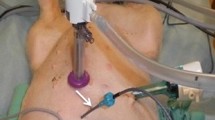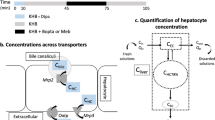Abstract
The aim of this study was to validate an experimental model designed to distinguish four categories of contrast agents, non specific agents (NDA, Gd-DOTA) characterized by rapid and total extravasation; low diffusion agents (LDA, P760) characterized by delayed extravasation; and rapid (P792) and slow clearance (P717) blood pool agents (BPA) characterized by limited extravasation.
Plasma and peritoneal gadolinium concentrations were simultaneously measured after intravenous injection of various contrast agents in mice. Products of each category were compared in this model.
The plasma pharmacokinetic profiles were similar for Gd-DOTA and P760 (t1/2 = 13.3 and 13.8 min. respectively), whereas the half-lives were 22 and 1212 min for P792 and P717, respectively. The plasma clearance was inversely related to the size of the contrast agent. The intraperitoneal diffusion patterns of the various products were related to the molecular volume; Cmax per dose decreased progressively (78.7, 51.2, 44.2, 33.5 1/1) and tmax increased (7, 15, 40, and 120 min) for Gd-DOTA, P760, P792 and P717, respectively. Nevertheless, the same quantities of Gd-DOTA and P760 (AUC ratio of 78.4 and 76.8, respectively) diffused into the peritoneum, whereas only 44.5% of P792 and 21.5% of P717 extravasated.
The data obtained in this peritoneal permeability model with the various categories of contrast agents provide an estimation of the quantities of contrast agents diffusing into a permeable interstitium and may be used to predict the corresponding signal intensity, which can be measured locally.
Similar content being viewed by others
References
Corot C, Violas X, Robert P, Port M. Pharmacokinetics of three gadolinium chelates with different molecular sizes shortly after intravenous injection in rabbits: relevance to MR angiography. Invest Radiol 2000;35:213–8.
Knopp M, Weiss E. Sinn HP, Mattern J. Brix G. Pathophysiologic basis of contrast enhancement in breast tumors. J Magn Reson Imaging 1999;10:260–6.
Brasch RC. Rationale and applications for macromolecular Gdbased contrast agents. Magn Reson Med 1991;22:282–7.
Manduteanu I. Corot C Simionescu N. Meyer M, Simionescu M. Experimental evaluation of the vascular effects and transport of an iodinated macromolecular contrast medium. Invest Radiol 1997;32:447–52.
Martin-Chouly C, Youmine H, Saiag B, Hentsch AM. Corot C. Legrand A. In vitro evaluation of vascular permeability to contrast media using cultured endothelial cell monolayers. Invest Radiol 1999;34:663–8.
Port M, Meyer D, Bonnemain B, Corot C, Schaefer M, Rousseaux O, Simonot C, Bourrinet P, Benderbous S, Den-causse A, Devoldère L. P760 and P775: MR1 contrast agents characterized by new pharmacokinetic properties. MAGMA 1999;8:172–6.
Port M, Corot C, Rousseaux O, Raynal I. Devoldère L, Idée JM, Dencausse A, Lancelot E, Le Greneur S, Bourrinet P, Bonnemain B, Meyer D, Lautrou J. Chemical, physicochemical and biological evaluation of P792: a rapid clearance blood pool agent for MRI. MAGMA, 2001;12:121–7.
Corot C, Schaefer M, Beauté S, Bourrinet P, Zehaf S, Benizé V. Sabatou M, Meyer D. Physical, chemical and biological evaluations of CMD-A2-Gd-DOTA: a new paramagnetic polymer. Acta Radiol 1997;38(Suppl. 412):91–9.
Corot C, Port M, Raynal I. Dencausse A, Schaefer M, Rousseaux O, Simonot C, Devoldère L, Lin J, Foulon M.Bourrinet P, Bonnemain B, Meyer D. Physical, chemical and biological evaluations of P760: a new gadolinium complex characterized by a low rate of interstitial diffusion. J Magn Reson Imaging 2000;11:182 -91.
Qing Z, Carlsson O. Rippe B. Clearance of tracer albumin from peritoneal cavity to plasma at low intraperitoneal volumes and hydrostatic pressures. Perit Dial Int 1998;18(5):497–504.
Zakaria ER, Rippe B. Intraperitoneal fluid volume changes during peritoneal dialysis in the rat: indicator dilution vs. volumetric measurements. Blood Purif 1995:13:255–70.
Rippe B. A three-pore model of peritoneal transport. Perit Dial Int 1993;13:S35–8.
Nolph KD, Miller F, Rubin J, Popovitch RP. New directions in peritoneal dialysis concepts and applications. Kidney Int 1980;18(Suppl. 10):S111–6.
Flessner MF. Peritoneal transport physiology: insights from basic research. J Am Soc Nephrol 1991:2:122–35.
Rippe B, Stelin G. Simulations of peritoneal solute transport during CAPD. Application of two-pore formalism. Kidney Int 1989;35:1234–44.
Leypoldt JK. Evaluation of peritoneal membranes pore models. Blood Purif 1992;10:227–38.
Wiederhielm CA. The interstitial space. In: Fung YC, Perrone N, Andeker M, editors. Biomechanics: Its Foundations and Objectives. Englewood cliffs, NJ: Prentice-Hall. 1972:272–86.
Flessner MF. The importance of the interstitium in peritoneal transport. Perit Dial Int 1996; 16(Suppl. l):S76–9.
Tofts P, Brix G, Buckley D, Evelhoch J, Henderson E, Knopp M, Larsson B, Lee T, Parker G, Taylor J, Weiskoff M. Estimating kinetic parameters from dynamic contrast-enhanced Tl-weighted MRI of a diffusable tracer: standardized quantities and symbols. J Magn Reson Imaging 1999;10:223 32.
Daldrup H, Shames D, Wendland M, Brasch R. Correlation of dynamic contrast-enhanced MR imaging with histologic tumor grade: comparison of macromolecular and small-molecular contrast media. Am J Radiol 1998:171:941–9.
Author information
Authors and Affiliations
Corresponding author
Rights and permissions
About this article
Cite this article
Bourasset, F., Dencausse, A., Bourrinet, P. et al. Comparison of plasma and peritoneal concentrations of various categories of MRI blood pool agents in a murine experimental pharmacokinetic model. MAGMA 12, 82–87 (2001). https://doi.org/10.1007/BF02668086
Received:
Accepted:
Issue Date:
DOI: https://doi.org/10.1007/BF02668086




